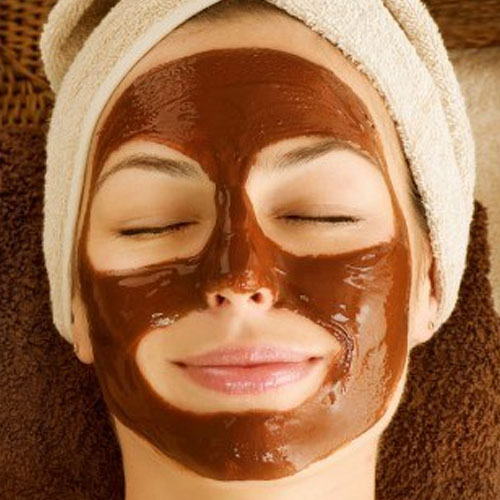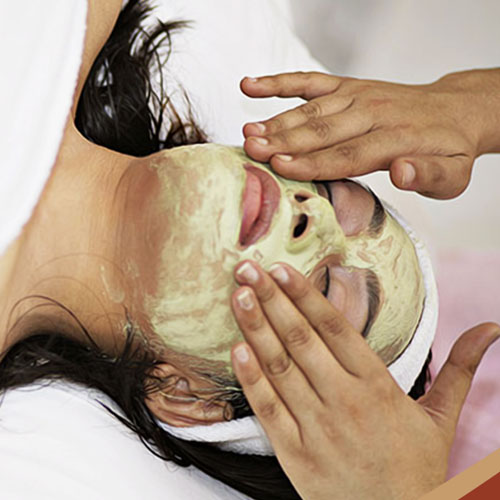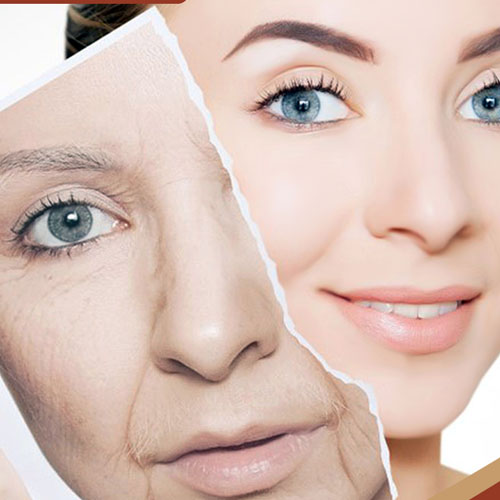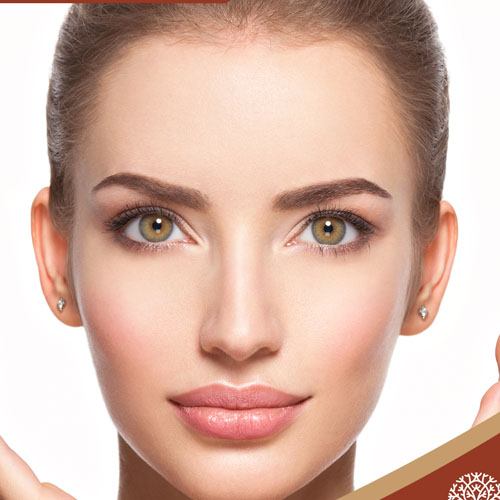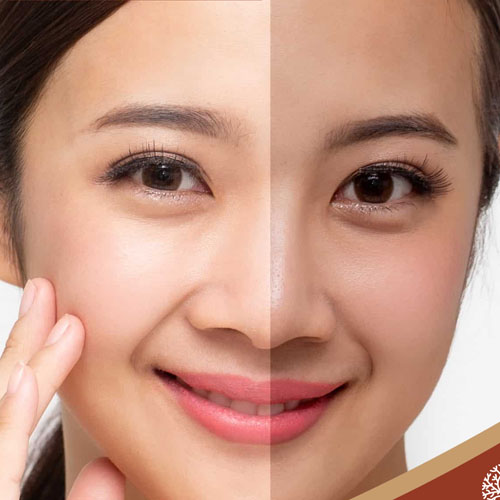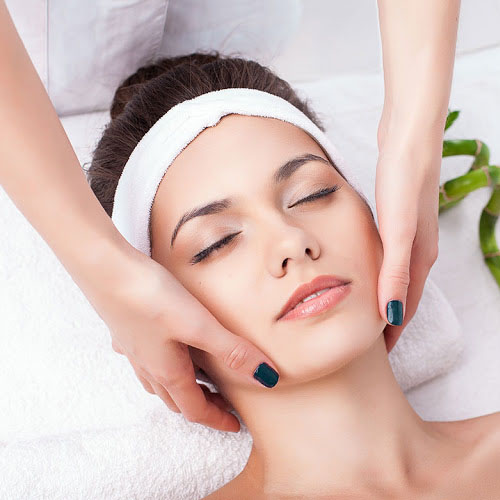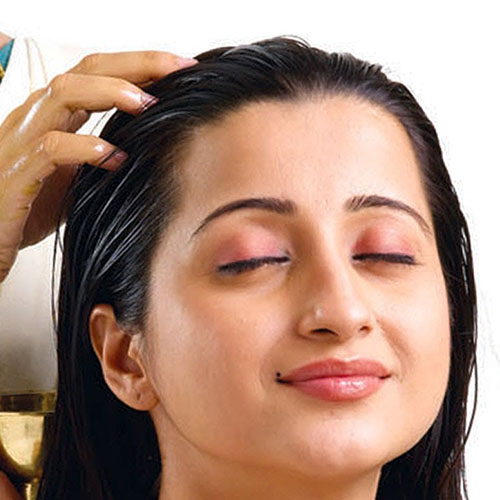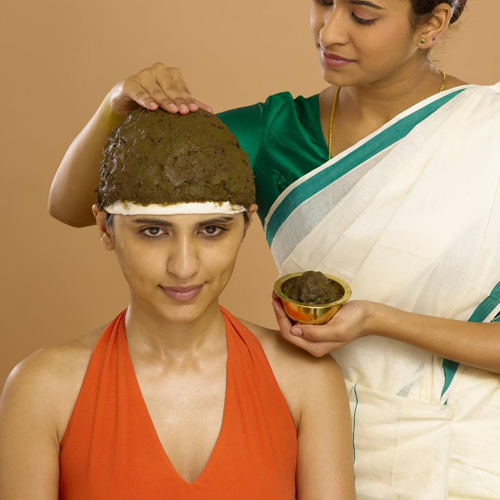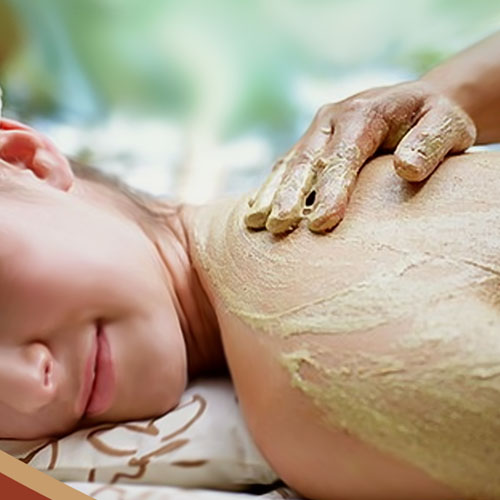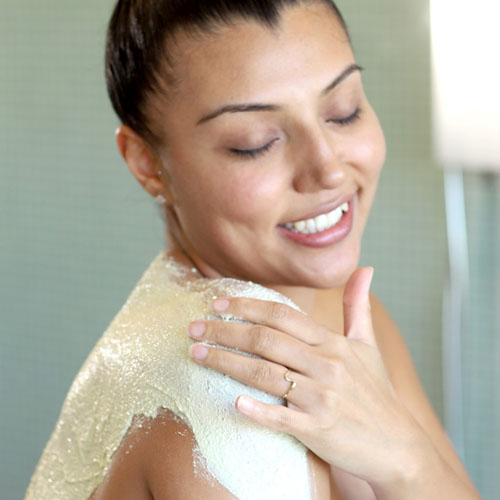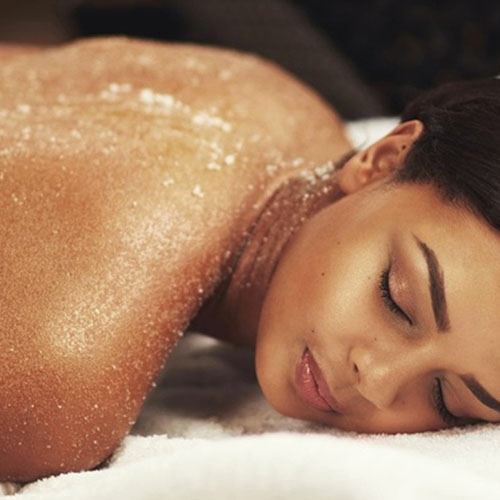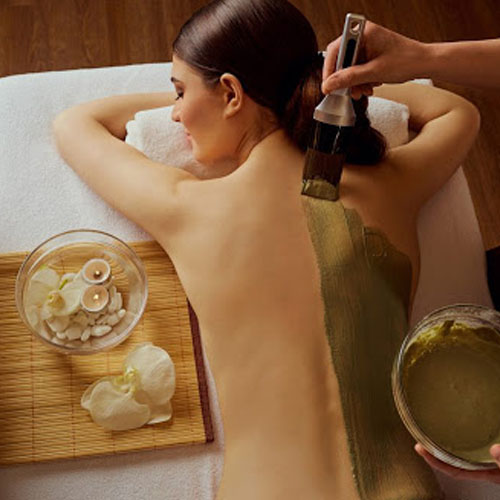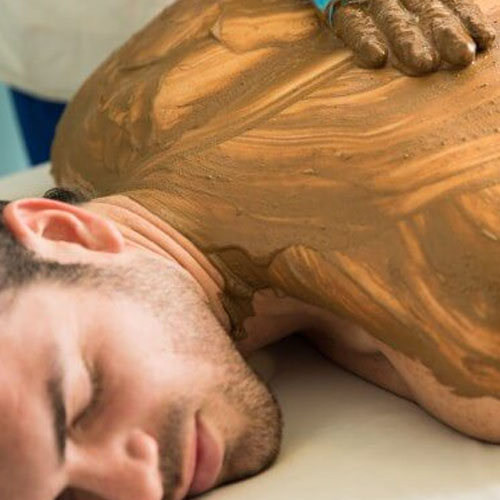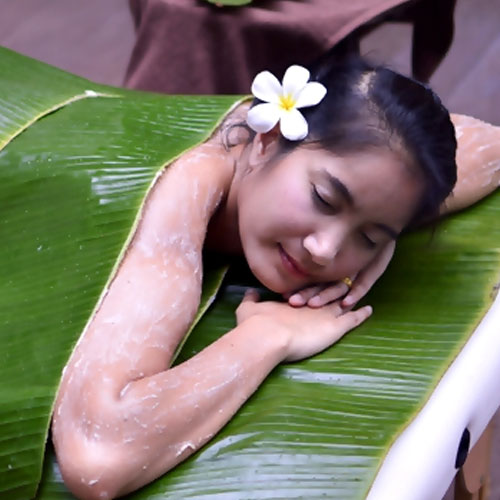Consultation
Nadi Pariksha

"precision in diagnosis to heal you"
Nadi Pariksha is the ancient ayurvedic technique of diagnosis through the pulse. It can accurately diagnose physical, mental and emotional imbalances as well as diseases. It is a non- invasive science that enables to reach the root cause of health issues and not just address the symptoms.
Nadi Pariksha understands the vibratory frequency of the pulse at various levels on the Radial artery. Subtle vibrations are read at seven different levels vertically downward that help in ascertaining various functions in the body. The pulse, when examined, reveals both physical & mental characteristics of the patient. This is interpreted in the form of symptoms along with their prognosis, which helps in understanding the cause. Thus, Nadi Pariksha forms the basis for addressing any ailment in an individual. Additionally, it is also the scientific tool that enables an individual to secure their personalized wellness regimes that range from therapeutic massages, personalized diet, exercise programmes, rigorous detoxification and lifestyle transforming experiences.
Prakriti Pariksha
Prakriti is a commonly used term in Ayurveda. Prakriti means one’s psychosomatic constitution or mind-body type. In Sanskrit, the word prakriti means nature. The concepts of prakriti or psychosomatic constitution is significant in Ayurveda. They are used extensively for examining patients, prescribing Ayurvedic treatments, and helping people maintain overall health and wellbeing.
Ayurveda believes that both our bodies and the entire universe are made up of these five elements. These five elements when combined form the three doshas of the body which are Vata dosha, Pitta dosha, and Kapha dosha. Vata dosha is mainly responsible for movements of the body, whereas the Pitta dosha is responsible for maintaining digestion, metabolism, and body temperature.
The Kapha dosha is mainly responsible for lubrication, cohesiveness, and body structure. Besides these primary functions, the three doshas are also responsible for many other important bodily functions. According to Ayurveda, yourprakritiis what determines your physical and mental characteristics.
A state of complete physical wellbeing is said to be achieved when these three doshas are in equilibrium. Any imbalance in these doshas is considered to be the root cause of diseases and disorders. An individual’sprakriti is determined based on theirpancha mahabhutas and threedoshas. This allows Ayurvedic practitioners to prescribe very specific treatment plans according to the individual’s unique constitution.
Identifying an individual’s physical constitution is an important step in devising a lifestyle and diet plan that is tailor-made for their particular constitution. While a person’s basic prakriti remains the same throughout their life, sometimes, due to drastic changes in physical, emotional, mental, or lifestyle conditions, one’s psychosomatic constitution can change.
Hair & Scalp Problems
There are many different types of hair out there, and we all want what’s best for ours. After all, the hair is usually one among the most prominent aspects of a person’s physical look, likely second solely to one’s face. If our hair didn’t matter to us in a collective sense, there wouldn’t be a multi-billion dollar hair care industry peddling their products on the market. The problem is that many of these products contain harmful chemicals that can have an extremely detrimental impact on both the hair and critical internal systems like the endocrine and nervous systems. Unfortunately, most hair products only manage to repair the hair superficially and sometimes only temporarily often damaging the hair in the process.
The Ayurvedic approach is different. Ayurvedic hair care employs each product and treatment methods that are 100% natural. Furthermore, the Ayurvedic tradition is intrinsically holistic. So whether you choose a topical treatment for the hair itself, a more systemic approach, or a combination of the two, Ayurveda aims to address the root cause of the problem which often originates well beneath the surface.
Before we talk about remedies, we need to understand the basic Ayurvedic system. According to Ayurveda, everything in the universe is made up of the five elements - air, fire, water, earth and ether - and the three doshas, namely vata, pitta, and kapha. Ayurvedic experts say that we can achieve sparkling health by balancing these within our body. Doshas apparently govern everything about us, from hair colour to body type to the kind of illnesses we can get afflicted with. Generally, we have one or two dominant doshas.
To put it simply, vata relates to air, pitta to fire and kapha to water. Vata's role is believed to be confined to our nervous system, pitta is responsible for digestion and metabolism while kapha lubrication of joints, strengthening of immunity and protection of body tissues. Aggravation of any of these doshas, for whatever reason, can lead to various kinds of diseases. Hair fall, experts say, is attributed to the exacerbation of the pitta dosha.
There can be various reasons for hair fall. These include weight loss, abysmal iron levels, irregular diet, stress and thyroid and hormonal imbalances, according to experts. A well-functioning body system is needed to control hair fall. In other words, the very root cause of hair loss needs to be tackled first - we need to cleanse our system from within to balance the doshas. And this is where Ayurvedic rituals can be of great help.
Excessive shedding of dead skin from the scalp is known as Dandruff. Skin cells die and flake off, so a small amount of flaking is normal. Usually, the scalp skin dies and flakes off during a month, while in those suffering from Dandruff, this happens every 2-7 days. Apart from being a physical condition, dandruff is also associated with social and self-esteem problems in many individuals. With proper care and Dandruff treatment, you can get relief from the problem. Ayurveda places the matter of dandruff within the category of Shudra Roga, which appears due to an imbalance of all three doshas (Ayurvedic humor). The primary doshas involved are Pitta and Vata. Pitta is an Ayurvedic humor which symbolizes heat or fire and Vata is dry and rough in nature. In an aggravated state, both doshas cause production of specific impurities, called ama, which are dry and heating in nature. These impurities accumulate in the deep tissues of scalp and contaminate them. Contamination of the deep tissues and aggravated Vata-Pitta Dosha cause itching and patches on scalp. Due to these factors, the scalp sheds larger than traditional amounts of dead epidermal cells, those results in the matter of dandruff.
Ayurveda focus on correcting the constitution for treating hair fall. Ayurveda considers the imbalance of Pitta as the chief cause of premature hair fall and graying. Dandruff is a Vata Kapha imbalanced disorder.
Siro Abhyanga : Oil therapy on the scalp.
Siro Dhara : Downy stream of medicated oil or buttermilk on the scalp.
Siro Vasthy : Oil retention in a Chef’s cap fitted on head.
Nasyam : Nasal drops.
Thalapothichil : Application of a herbal paste on the scalp.
Skin Diseases
The skin is the largest external organ as well as the largest organ in general in the human body. There are many types of skin diseases that can afflict your body and they may appear anywhere. Ayurveda may be a potent weapon that may be used to treat many skin diseases effectively. The natural remedies of Ayurveda are being more and more adopted throughout the world.
Types of skin problems:
Psoriasis - Ayurveda has great treatments for this disease as its incidence inside the population is sort of high. This is a non-infectious skin condition wherever inflammation happens within the affected elements of the skin and chromatic scales form on the body. This problem is usually attributed to excessive cells within the body.
Seborrhoeic dermatitis - Caused by the aggression of yeast - Pityrosporum ovale - which lives on our skin. Dandruff-like flaky, itchy rashes on our scalp and face results.
Acne - Acne is a skin disorder in which there is excess production of oil from the sebaceous glands resulting in the blockage of hair follicles. It is the foremost common drawback of adolescents, and is therefore known as Yauvanpidika in Ayurveda; yauvan means ‘adolescence’ and pidika means ‘pustules or papules’. Acne typically affects the face, back and shoulders and other areas that are densely populated with sebaceous glands. Acne presents either as blackheads, whiteheads, pimples or nodules. Ayurveda provides effective root-cause acne treatment.
Vitiligo: Vitiligo or Leucoderma could be a pigmentation disorder during which melanocytes (the cells that create pigment) within the skin are destroyed. As a result, white patches seen on the skin in several parts of the body. Similar patches also appear on each mucous membranes (tissues that line the inside of the mouth and nose), and the retina (inner layer of the eyeball). The hair that grows on areas affected by Vitiligo sometimes turns white. The most widely accepted read is that the depigmentation happens because Vitiligo is an autoimmune disease - a disease during which an individual’s immune system reacts against the body's own organs or tissues.
Eczema - One amongst the foremost common kinds of skin diseases, eczema is characterized by the reactions that the skin has. These reactions can manifest themselves in many forms. The most common reaction is swelling of the skin with redness. Other forms may additionally develop blisters, cracking of the skin, scaling or papules.
Urticaria or Hives - These rashes differ from other ones as they persist for a short period of time and usually result in swellings on the skin. These swellings may be very sensitive and itchy. Some common examples of Urticaria are Nettle rashes and hives which will develop because of an external factor like as bug bites.
Ayuryoga’s Ayurveda Therapies - According to Ayurveda, the common factor of all skin conditions is the impurity or imbalance of Rakta (Blood tissue). Incompatible food, stomach upset, excessive and regular intake of fishes, milk, sour & salty foods, yogurt, horse gram, radishes, shellfishes, jaggery, oily foods are described as causes of Rakta imbalance. Calc Sulf, Apis Mel, Sulphur, Graphites, Petroleum, Kali Sulph, Mezerium are very effective Homeo remedies for skin conditions. Unani herbs like, Ushaba, Chopchini, Unaab, Shahtra are equally good. Traditional Complementary & Alternative Medicine gives a clinically significant improvement in arthritis on compare with allopathy treatment with the added advantage of lesser side effects. According to Ayurveda, arthritis is due to the imbalance of Vata. The Vata balancing herbs and therapies are time tested and are free from side effects.
Psoriasis Care
Psoriasis is an inflammatory skin disorder characterized by reddish plaques covered by silvery scales. A minimum of 21 days of ayurvedic treatment is required to control this skin disorder. But prolonged treatment and follow-ups might be necessary according to the stage of the disease.
Vaidhyas suggest a combination of treatment, including the first cleansing and preparation of the body for treatment. This unique treatment program includes various ayurvedic therapeutic procedures like Lepanam, Abhayangam, Snehapanam, Kashaya Dhara, Thakradhara, etc.
The treatment procedures, their timings and doses are modified and tailored for each patient according to the body structure and stage of disease after the initial consultation and physical examination by the physician.
Hair Fall
Hair fall has been described in Ayurveda by the name of khalitya roga under the heading of kshudra roga minor disease or shiroroga. It is a progressing disorder found in people living sedentary lives with stress inducing hectic schedules along with indiscriminate dietary habits resulting in many a disturbance and deficiency in the body which directly reflect on hair, resulting in hair loss. Ayuryoga can reduce & manage this rising problem of hair fall through modifying life style, purification therapies and medication as prescribed by the ancient texts of Ayurveda.
Ayuryoga suggests that healthy and vibrant hair helps a lot in the improvement of one’s personality. Therefore, to keep hair in healthy state is the entirely duty of the human being, because just like face, hair is also a mirror of healthy state of body.
Ayuryoga uses Shirodhara to address hair related concerns, wherein warm oils or liquids formulated with soothing Ayurvedic herbal ingredients are poured on the patient’s forehead from an oscillating container hung above. While the medicated liquid or oil travels down from the forehead to your scalp, the therapist gives a gentle massage on your scalp. This has an immensely soothing and cleansing effect on your nervous system.
The warm medicated oils are gently poured on the area of action and massage is given by various kinds of hand movements to stimulate pressure points in that area. The head massage in Shiroabhyanga enhances the flow of oxygen and blood into your scalp, thus, ensuring nutrient supply to your follicles. A regular Shiroabhyanga promotes healthy nourishment to your hair.
Nasyamis also suggested by the experts at Ayuryoga. Here, oil is instilled through the nose as a daily practice to provide relief from various ailments. Ghee and Anu Tailam are dripped into the nose. There are also other Ayurvedic treatments for hair growth to help you sport an enviable crown.
Along with these treatments for hair growth, Ayuryoga also looks into your diet and your food habits as major factors in determining the quality and quantity of your hair.
These observations are important as they help in understanding the scalp and the reason for hair fall better, preventing heating up of the scalp, help preventing greying and nourishes your sensory organs.
The plan is to always help your head remain cool, lend support to hair follicles and nourish nerve endings. The hormones released keep you happy. Shirodhara, Shirovasthi and Abhyangam are highly recommended by Ayuryoga as remedies for hair loss which restore blood circulation to your nerve ends resulting in better hair.
Ayuryoga suggests Abhyangam for people with hair thinning & premature greying. In addition to a Pitta balancing hair care regimen, a regular abhyangam is extremely useful to help rein in aggravated Pitta dosha.
The abhyangam practice works in tandem with the hair care regimen to help control all the effects of Pitta aggravation (if detected early and followed through diligently). Special diet precautions must be taken fully on Abhyangam days and followed as far as possible on mini abhyanga days also.
Rheumatic Disorders Management
Rheumatoid arthritis, an inflammatory disease that affects the joints of hands and feet, particularly the synovial joints, causes acute pain and swelling, ultimately resulting in joint deformities and bone erosion. It is an autoimmune disorder triggered when our body's immune system mistakenly starts attacking our tissues. Apart from the joints of hands and feet, rheumatoid arthritis can also affect the organs, including skin, eyes, lungs, and blood vessels. Although arthritis is commonly found among those beyond the age of forty, it needn't be the same in every case.
According to Ayurveda, Vata dominance or aggression is the leading cause of arthritis. Upon aggravation, Vata combines with Ama, otherwise known as toxin, and gets accumulated in various joints of our body, thus causing 'Amavata.' Improper digestion is one of Ama's leading causes or undigested toxic material.
Muscular Pains & Aches
Ayurveda identifies two major types of joint problems. The first kind is associated with poorly-nourished joints or low bone density and overall weakness in the joints. This kind of drawback starts with some discomfort, a cracking sound, and if not taken care of, leads to eventual immobilization of the joints. Because the bone is not obtaining the nourishment it desires, it starts to degenerate. The second kind is related with a toxic overload in the joints, and is the result of too many toxins in the body. As ama (the sticky, toxic waste product of incomplete digestion) accumulates in the joint, it first creates stiffness and heaviness. If it stays there for a long time, the joint can become swollen and painful. Damp, cold weather can aggravate this type of joint issue.
Shoulder Pain: A frozen shoulder can be used due to heart or lung problems and also diabetes, especially in people aged over 40 years. According to ayurveda, a frozen shoulder is known as Ababahuka. It is pure vata roga. Vitilated vata dosha absorbs the fluid at the joint causing Ababahuka
If frozen shoulder caused by secondary group, panchakarma and kerala therapy are very effective. Ayurveda Treatment aims to bring vitiated vata in equilibrium. Most popular therapy is pizhichil (Squeezing of medicated oil with the help of cotton cloth all over the body along with therapy)
Neck Pain
Neck Pain is incredibly common. Research proves that at least 70% of the population suffers from some form of neck pain There are two basic types of pain: acute & chronic and it is always good to know the type of pain you are dealing with. Acute pain is severe and sudden in onset. It’s a flare-up of pain. Ayurvedic treatment for neck pain is based on the cause of the neck pain and often it is because of muscular spasm caused by strain due to posture or due to stress.
It could be because of a trauma or maybe not. At Ayuryoga, our experts know that most instances of neck pain are caused due to prolonged or repeated movements of the neck that normally results in a strain or a sprain or a spasm of the neck muscles.
Podikizhi relieves many types of joint and muscular pain, Podikizhi is the common type of Ayurvedic massage technique that helps in alleviating pain and reduces swelling occurred due to arthritis, muscular spasm and rheumatism. Treatments at Ayuryoga are aimed at relieving body ache and strengthens muscles and skin. Management of neck pain include bringing down the vitiated Vata and reducing strain.
Elakizhi or Patrapotala Sweda is another sudation practice in Ayurveda treatments. It is a highly rejuvenating treatment similar to Navarkizhi, except herbs are used in place of rice. Ayuryoga uses this concept that involves sweating as a result of the massage helps to eliminate accumulated impurities adequately, and the therapeutic effects of the prescribed natural leaves remove abnormal fluid retention or swellings associated with any inflammatory changes. Another unique healing program is Abhyangam where the prescribed oil is liberally applied using soft and gentle strokes, followed by a steam bath. Warm herbal oils are concocted to nourish and revitalize the tissues and to allow the removal of toxins from the body.
Ayuryoga also uses Abhyanga, characterized by long strokes, flowing movements and point therapy, heightens awareness in order to direct the internal healing system of the body.
Ayuryoga also treats neck pain that has been referred to as Manyagata Vata in Ayurveda. It is caused by aggravated Vata dosha that is lodged in the cervical or neck region. Management of neck stiffness include bringing down the vitiated Vata and reducing strain to the cervical region. Nasyam another therapeutic administration of medicines through the nasal passages is also considered effective for neck pain and Cervical Spondylosis.
Ayuryoga also recommends Pizhichil where, a warm medicated oil is continuously poured on the body along with gentle massages. Recommended for rejuvenation and reducing pain and inflammation, the therapy is effective for neck pain too.
Frozen Shoulder
According to Ayuryoga frozen shoulder is usually caused by traumas or periods of immobilization or even diseases like diabetes. For the affected, holding the shoulder in one position for long enough may actually lead to it getting stuck there. The shoulder is the only joint that always “freezes” in most of the scenarios. Even simple movements like raising the arm, putting your clothes on, combing hair, etc. become nearly impossible to perform.
There is a tissue around shoulder joint called the Shoulder Capsule that holds it together. In the case of a frozen shoulder, the capsule becomes thick and tight which makes hard to move the shoulder. Ayuryoga treats this adhesive capsulitis as a condition affecting connective tissue surrounding shoulder joint causing inflammation, stiffness, restricted movements and chronic pain.
The Ayurvedic treatment provided here aims at treating stiffness and pain, and preserving shoulder joint movements. Pain relieving massages with medicated oils and herbal fomentation/heat therapy is helpful in reducing pain and stiffness. This is followed by herbal Ayuryoga medication as well.
Ayuryoga uses Podikizhi method of fomentation in which cotton poultices filled with a mixture of powdered herbs in hot medicated oil are used to rhythmically dab and massage the body. Podikizhi at Ayuryoga is an effective treatment for rheumatism, joint pain, slip disc, sciatica, frozen shoulder, back pain, spondylitis, muscular pains, inflammation, etc.
Navara is a type of rice and Kizhi means poultice. Navara rice is cooked in decoction of Bala, etc. and then tied into a kizhi which is made of kora cloth. The kizhi is dipped in herbal decoctions and is rhythmically dabbed all over the body. It is an immunity-enhancing treatment which we practice at Ayuryoga. It is highly effective in treating neurological problems, muscular wasting, and rheumatic disorders like joint and muscular pain.
This therapy eliminates muscle spasms, strengthens weak muscles and also alleviates burning sensation. At Ayuryoga special therapies like Abhyangam, Nasyam, Elakizhi, Navarakizhi are also implemented in treating frozen shoulder.
Frozen shoulder treatment through a combination of our proprietary Ayurvedic formulations and traditional Ayurvedic combinations and the full range of Ayurvedic therapies are administered by our Ayuryoga team of experienced ayurvedic physicians and trained therapists.
Ayuryoga’s treatments include internal and external therapies and medications in order to remove the offending toxin permanently from the body. In the Panchakama treatment, use of oil massage also called as Abhyangam, steam bath called Swedanam along with Nasyam and Navarakizhi (which is a unique Panchakarama treatment) are usually implemented.
Ayuryoga’s experts advise a preventive approach to Frozen Shoulder as well. We have found that patients who follow our protocol are able to lead a much better quality of life. These therapies are highly targeted and work on eliminating all the toxins from the body, and treating stiffness and pain and ultimately preserving the joint structures naturally. Permanent relief from symptoms is the definitive cure for this disease.
Lower Back Pain
Lower back pain is a very common and pervasive health complaint. There are three fundamental constituents of the individual body and the world around us — with each made up of a different combination of the five great elements: ether, air, fire, water, and earth. Pitta dosha is made of fire and water, and Kapha dosha is made of earth and water. Vata dosha is made of ether and air, and this is the dosha most commonly involved with lower back pain.
Evaluation of personal lifestyle and fitness is crucial to managing lower back pains through guided medical practices at Ayuryoga. Lower back pain is universally understood as a marker of an underlying disease and it is the most common symptom that makes a person to seek our physician’s advice and care. Ayuryoga balances the Vata and Pita dosha and also rejuvenates and nourishes the body through therapies likes Navarakkizhi that stimulates the nervous system. Ayuryoga helps reduces vata dosha, which works wonders in reducing pain, particularly lower back pain.
Abhyanga is a healing therapy that Ayuryoga recommends as a massage that can be performed on anyone using warm medicated oil for back/body pain and the need for relaxation. This is one of the key components of back pain treatment in Ayurveda. Ayuryoga also uses other methods such as Kativasthi which is a popular Ayurvedic treatment, in which heat is applied to low back region using warm medicated oils. First, a dam is built up, using an herbal dough, over the affected area. Warm medicated oil is poured into this area and then left to rest there and it works like magic relieving pain and swelling in the affected area.
Ayuryoga also recommends Vasti as another important treatment in Ayurveda and especially for rheumatic (vata) diseases. In Panchakarma, Vasti plays a key role and it ensures result and guaranteed relaxation to vata disorders. It has the power to remove toxins from human body.
Navarakkizhitreatment for back pain is one of Ayuryoga’s famous therapies which involves the fomentation of the body with a bolus of cooked rice. Navara is a rice variety known for its medicinal properties and it is cooked in milk, to form an herbal decoction using Kurumthotti. Navarakizhi provides nourishment and strength to body tissues including bones, muscles and soft tissues. It is also used for the purpose of rejuvenation of the body.
Ayuryoga also uses Panchakarma that is a detailed, individualized detoxification therapy which includes a deep cleanse or rejuvenation after the treatment. Panchakarma alleviates many chronic conditions, improves immunity, rejuvenates the whole system and strengthens the skeletal and nervous system. Ayuryoga also suggests correct sitting postures while reading, watching television and eating. Use back-friendly sofas and easy chairs at home. Maintain good posture etiquette while at work which starts with finding the right worktable and chair
Arthritis
Ayurveda is an ancient variety of medicine that started in India. It uses nutrients, exercise, and meditation along to encourage good health. Combining bound nutrients and different supplements with trendy medicine is also helpful if you have arthritis. The main symptoms of arthritis are joint pain, stiffness, swelling, redness and limited movements. Patients having joint injuries, inactive lifestyle, diabetes, thyroid problems, overweight, smoking, hysterectomy (removal of the uterus) are at higher risk of developing arthritis. The most common types of arthritis Dr.specialize are
Osteoarthritis:
Osteoarthritis, or OA, is the common form of arthritis, affecting up to 15 million Indians every year. OA is also called degenerative joint disease. It usually develops after age 45 but juvenile osteoarthritis is also a growing concern. The most common symptoms are pain and stiffness in the hips, hands, knees, lower back and neck joints mostly felt in the morning.
Ayurveda offers many herbal treatments for the treatment of Osteoarthritis. These plants have documented anti-inflammatory properties while not the aspect effects of normally prescribed medications. For example, at a recent meeting of the American College of Rheumatology, a study was presented that showed an herbal Ayurvedic therapy to be as effective in treating knee osteoarthritis as a commonly prescribed medication (Celebrex) and glucosamine – and with fewer side effects.
Rheumatoid arthritis:
Rheumatoid Arthritis (known as Amavata in Ayurveda) is an autoimmune disease that causes chronic inflammation of the joints. It may also cause inflammation of the tissue round the joints, in addition as in different organs within the body. Autoimmune diseases are diseases that occur once the body's tissues are mistakenly attacked by their own immune system. Patients with response diseases have antibodies in their blood that concentrate on their own body tissues, where they can be associated with inflammation. Because it will have an affect on multiple other organs of the body, Rheumatoid Arthritis is referred to as a systemic illness and is sometimes called rheumatoid disease.
Increased intake of indigestible, heavy and incompatible foods; having food at improper times; indigestion; intake of milk and milk products, especially yogurt; intake of meat of aquatic animals; lack of physical activity or doing exercise once having fatty foods are some of the common causes of Rheumatism. Improper food habits and inactive lifestyle will result in impairment of digestive fire, formation of ama (toxin) and vitiation of Vata (air). When an individual indulges in Vata-aggravating diet and lifestyle, then this aggravated Vata circulates ama in the channels of the body and deposits it in the joints, causing Amavata. Ayurvedic treatment of Rheumatism Arthritis starts with pacification of Vata and elimination of toxins from the body. Herbal medicines are administered to enhance the digestive fire and stop any formation of ama. Panchakarma massage therapies are quite useful in subsiding pain in Arthritic patients.
Gout:
Gout may be painful metabolic illness leading to inflammation and therefore the deposition of uric acid in the cartilages of the joints. Gout first affects the big toe inflicting it to swell and become terribly painful. In the next stages it spreads to the ankles, knees, joints of hands and feet, the wrist and elbow.
When the human body breaks down the chemicals known as purines, it produces uric acid. Purines are found naturally in our body as well as in food. Normally, uric acid dissolves and goes through the urine via the kidneys. But if the body is manufacturing an excessive amount of uric acid or if the body is not excreting enough uric acid, it starts accumulating in the body. This build up leads to the formation of sharp, needle like crystals. When they accumulate in the joints or surrounding tissues, it causes pain, inflammation and swelling.
In Ayurveda, gout is known as vatarakt, as the main dosha involved is vata and it affects rakt dhatu. Vitiation (impairment) of vata dosha and rakt dhatu is caused by increased intake of spicy, sour, salty, alkaline, heavy and penetrating foods. The impaired doshas travel through the channels of the body and acquire accumulated at the smaller joints causing injury to the tissues and bones of the joint leading to vatarakt. Excessive anger, waking up late in the night, sleeping in the daytime, excessive travelling, trauma, overindulgence in physical exercises, excessive sexual activity and suppressing the natural urges of the body can also lead to gout. Ayurvedic treatments emphasize herbal preparations, diet and routines that facilitate to cleanse the blood.
Ayuryoga's Ayurveda Therapies: Ayuryoga's Ayurveda therapies & medications can safely and effectively reduce inflammation in your joints; it relieves pain and prevents joint damage. Traditional Complementary & Alternative Medicine gives a clinically significant improvement in arthritis on compare with allopathy treatment with the added advantage of lesser side effects. According to Ayurveda, arthritis is due to the imbalance of Vata. The Vata balancing herbs and therapies are time tested and are free from side effects. As per Ayurveda medicine, the proper balance of - air, food & drink; body movement & rest; mental work & rest; sleep & wakefulness; retention & evacuation - can avoid the development of Arthritis.
Lepam - Application of herbal paste.
Abhyangam - Oil massage.
Udgharshanam - Rubdown with herbal powder.
Udvarthanam - Oil therapy preceded by rubbing with herbal powder.
Kizhi - Application of warm herbal compress.
Janu Vasthy - Retention of oil on knees.
Pizhichil - Drizzling of medicated oil from a particular height.
Upanaham - Poultice or bandages.
Virechanam - Purgation or laxative therapy.
Vasthy - Enema therapy.
Cervical Pain
Cervical pain is characterized by deterioration of the neck joints and a decrease in density of the cervical spine. It may manifest as Cervical Spondylosis presenting itself with or without compressing the nerves. Ayuryoga treats cervical pain with the understanding of how it is caused by Vata Dosha aggravation. This is caused by unhelpful habits and a Vata aggravating lifestyle and food. So treatment for this issue focuses on calming the Vata Dosha.
Treatments at Ayuryoga involves medication to nourish the bones and the cervical discs. Sleeping properly and eating freshly prepared nutritious food prevents Ama formation in the body and reduces the inflammation and pain in the joints.
Ayuryoga addressing the root-cause of the disease begins by detoxifying the body so that medicines can work better towards treating the actual root-cause of the disease. The patient is advised on avoiding the intake of Vata enhancing foods. Medication for the problem is also supplemented with the topical application of Ayurvedic oil for cervical spondylosis. More severe cases of cervical spondylosis require external Ayurvedic medicine application as put forth by Panchakarma treatments methods. Panchakarma, Snehanam and Swedanam are highly recommended for cervical pain according our medical experts at Ayush Ayurveda Singapore.
Ayuryoga recommends Panchakarma in Ayurveda which means five types of therapeutic ways of treatment to eliminate toxins from the body and to replenish the tissues of the patient. This therapy dilates the body’s channels facilitating the elimination of toxins. In addition to this, it reduces the body’s stiffness. Panchkarma constitutes the foremost Shodhana Chikitsa. Panchakarma is an Ayurvedic rejuvenation treatment, since it not only eliminates the toxins causing diseases, but also replenishes the tissue with nourishment; and therefore it is termed as a rejuvenating therapy. Ayuryoga also suggests Snehanam (Oleation). This therapy involves administration of medicated oils either internally or externally.
At Ayuryoga, Elakizhi is commonly done as part of the Ayurvedic Panchakarma treatment though it can be used as a stand-alone treatment too. This classic massage with medicated leaves helps in relieving stiffness of muscles and joint pains, especially backache, lubricating joints, improving peripheral blood circulation, cleansing the channels of circulation and expelling toxins from the body.
By proper oleation and heating creating a sweating process, the body starts eliminating impurities through the skin. It is also very effective in reducing pain and oedema of the body caused by arthritis or other physical traumas. This treatment is particularly effective in conditions such as gout and arthritis where the joints are inflamed and painful. Ayuryoga uses this combination of heat, herbs and oil in the poultices to reduce pain and restore mobility to the joints. Swedanam is another form of sudation therapy where herbal steam is applied evenly on the entire body to produce perspiration. In this treatment method, the patient is made to sit or lie down in an enclosed herbal steam chamber. The apparatus is designed to allow the patient’s head to stay out of the way of the steam.
Swedanam reduces inflammation and congestion in the joints. This treatment delays the process of ageing, improves luster of skin, strengthens muscles and tissues, provides psycho-physical smoothening by promoting blood circulation. Ayuryoga uses this effectively, applying it scientifically in cases of post-traumatic injuries to muscles and joints, restoring flexibility and strength. Swedanam can be effectively utilized in treating muscular stiffness and numbness, and has been found to enhance the body’s blood circulation.
Knee Pain
Knee pain is more common than one would imagine. And it’s not just the problem of the aged. Knee pain can also be caused by sprain or contusion which automatically eases with time. Proper rest and home remedies come to rescue in such cases. But for major issues, a doctor’s intervention is necessary.
Ayuryoga has an exceptional Ayurvedic approach and remedy for knee pain, it is very important to investigate and understand the cause of the pain through detailed physical examination taking the help of radiology and pathological tests before treating the cause.
According to Ayurveda, ‘vata dosha’ is the sole reason for joint and knee pain. Treatments at Ayuryoga are provided for all age groups. The specialty of Ayurveda is the root cause of the illness is found and treated. Thus, it avoids the recurrence of the disease to a great extent.
Panchakarma purification therapies like Virechana followed by Basti for obesity related arthritis and the related knee and joint pain is provided here among others. These therapies are aimed towards reducing inflammation, improving tissue nutrition, promoting tissue healing, improving circulation, regularizing lymphatic drainage and reducing swelling. Ayuryoga treatment not only prevents further deterioration in the joints but also rejuvenates damaged cartilages.
Elakizhi is one of primary therapies that help with the issue of knee pain/joint pain. It is the inclusion of herbal leaves in the preparation of bouls depending on the condition of the individual. Ayuryoga uses specially formulated Ayurvedic oils for application on the whole body/affected area. The prepared bolus is heated in a small quantity of medicated oil and is applied over the body as soft punches.
Elakizhiis a part of panchakarma treatment in Ayurveda. Patrapotala swedam (Elakizhi) is an innovative classical massage with medicated leaves. Ayuryoga enchases peripheral blood circulation, cleanses the channels of circulation and expels toxins through the sweat and refreshing the body. This treatment is also known as leaf bag (ela kizhi) massage. The benefits of Patrapotala swedam (Elakizhi) are relieving spasm and stiffness of muscles, lubricating joints, strengthening the spinal muscles and relieving joint pain, especially back ache. In Elakizhi, it takes a day for its preparation as fresh leaves are to be collected and prepared for the bolus.
Navarakkizhi, another highly recommended treatment at Ayuryoga involves a unique fomentation of the body with a bolus of herbal rice (Shastika a particular kind of rice known for its nutritional value) cooked in milk, and an herbal decoction made of kurumthotti (Sida rhombifolia). This treatment makes the body supple and removes stiffness.
The approach to management of knee/joint pain at Ayuryoga is multipronged and is targeted to treat the cause and not just the pain. The best part of Ayuryoga is our strict adherence to Ayurvedic processes, herbs and oils as prescribed by the ancient texts on the subject.
Metabolic Syndrome
Metabolic syndrome is a multi-factorial disease, frequently associated with a cluster of pathologies including obesity, hypertriglyceridemia, impaired glucose tolerance, and insulin resistance, collectively referred to as the metabolic syndrome (formerly known as syndrome X and insulin resistance syndrome). It is present in 25–50% of the United States population .There has been a heightened awareness of the metabolic syndrome and a subsequent increase in clinical attention directed towards prevention, because of its sturdy association with premature morbidity and mortality. In particular, these risk factors predispose the individual to greater risk for developing cardiovascular disease and Type 2 diabetes. The absolutely developed metabolic syndrome without complications may be compared with Apathyanimittaja prameha and sophisticated stage of metabolic syndrome may be compared with Updrava of Avaran. Ayurveda treatment of metabolic syndrome depends on its various stages.
In Ayurveda, Agni has been described to have a pivot role in human body, especially in all metabolic processes. Mandaaagni (poor digestion/metabolism) is mainly caused by vitiated kapha dosha and it has been told to be the root cause of almost all diseases. Among the sapta dhatus (seven body tissue), meda dhatu simulates with fat or adipose tissue.
Diet plays an important part for the development of metabolic syndrome. Improper dietary habits particularly over consumption, excessive heavy diet, excessive meat and fish, sugarcanes preparations, milk and its preparations increase the kapha dosha in body. Therefore, this kapha dosha produce excess tissue, mucous, fat and that helps to retain the fluid in body. Excess kapha dosha additionally causes the accumulation of fat those effects on elevated cholesterol and triglycerides level in blood. The imbalance kapha dosha also slows down the metabolic power as a result disturbs in metabolism and ultimately leads to weight gain. So Ayurveda considers the diet as medicine and is classified according to their taste, habitat and pattern of metabolism. As the metabolic rate is varies in different individuals so suitable selection of diet is very important for blanching state of human. According to Ayurveda the human body is dominated by three elementary lifeforces; these are called biological humors of human body. The three humors are Vata, Pitta and Kapha. These are often translated as "wind", "bile" and "phlegm". Vata is additionally often known the biological air-humor, pitta the biological fire-humor and kapha the biological water-humor. These all three humors manifest in the body by maintaining and controlling the chemical, hormonal and electrical functions of the human body. The rasa or taste of diet depends on the predominance of particular humor for keeping the body free from diseases.
The eight factors like prakrti (qualitative characteristics of diet) karana (processing of diet), samyoga (combination of diet), rashi (quantity of diet), desha (habitat of diet), kala (time as per age, season and condition), upayoga samstha (variable edibleness of various diet) upayokta (the one who takes the diet) ought to be thought about before taking the food. Because it facilitates the proper digestion, assimilation and nourishment to the body. Ayurveda suggests taking balanced food that contains six sorts tastes like sweet, sour, saline, pungent, bitter and astringent. Ayurveda additionally mentioned some theories throughout taking of food. Food ought to soak up hungry state and regular intervals. The speed of taking should not so fast and quantity of diet ought to be sufficient and that depends on the biological process of individuals. Having water in between food is advisable, instead of before or after food. At the end of diet, should take sweet food including milk, ghee, rice, wheat and other grains and legumes, as well as sweet fruits, dates, honey, jaggery and sugar for balancing the pitta because pitta is responsible for digestion in human body. Furthermore, sweet taste nourishes and invigorates the mind, relieves hunger and thirst, increases tissues and improves the immune system.
Eye Diseases
According to Ayurveda the eye is created and continues by the Fire Element. As such, the eye is negatively affected by excess heat, and just as the tears of the eye, as well as the aqueous function to nourish and cool the eye, Ayurvedic recommends supportive measures to balance the Fire Element. This includes hygienic measures such as washing the face three to four times a day, taking regular baths, a healthy diet, living and working in areas with adequate ventilation or outside in the fresh air, and the ancient practice of peering at the cooling rays of the moon.
Glaucoma: Glaucoma is that the second leading reason behind of irreversible blindness worldwide and third leading cause in India. The disease progresses even intraocular pressure (IOP) is well under control. Hence, now modern medicine is looking for strategies that are neuro protective is glaucomatous optic neuropathy (GON) management. There are two major categories of glaucoma: Open angle glaucoma and narrow angle glaucoma.
The gradual loss of vision caused due to glaucoma instills the fear in the minds of patients about can glaucoma be cured. The allopathic treatment for this disease includes the use of medications or laser therapy depending upon the severity of the symptoms. Patients may also be prescribed eye drops that are aimed at lowering the intraocular pressure. In severe cases, surgery may be recommended.
Ayurveda offers eye supplements for glaucoma, which help to manage this disease without causing any discomfort. Hence patients who are apprehensive about how to cure glaucoma are advised to seek an ayurvedic treatment to ensure holistic recovery.
Cataract: A cataract is an eye disease in which the clear lens of the eye becomes cloudy causing decrease in vision. It is a common disease and most cataracts are a result of the aging process. In the development of age-related cataract, the power of the lens may be increased, causing near-sightedness (myopia). Cataracts generally progress slowly to cause vision loss and are potentially blinding if untreated. It usually affects both eyes but one of the eyes is always affected earlier than the other. Cataract treatment at Dr.Jasna Ayurveda offers a combination of personalized medicines, diet and lifestyle which works on the root-cause of the disease.
The lens of the eye is chiefly constituted of water and proteins. The protein is organised during a specific method that keeps the lens clear and permits light to pass through it to focus a clear image on to the retinal surface. As we age, some of the protein binds together and start to cloud a small area of the lens. This is how age-related cataract is caused. Over time, the cataract may become denser or cloud more of the lens making it more difficult to see. However, it should be noted that cataract is not a growth or tumor.
In Ayurveda this disease is named timira or linga nasha. Aggravated vata is considered to be responsible for the manifestation of this disease. One of the properties of vata is to make things dry up. When the lens of the eye loses its transparency, vision becomes blocked. This condition is known as a cataract. If started at an early stage, Ayurvedic Cataract treatment is very effective. During Ayurvedic treatment the aim is to alleviate the aggravated body energies and nourishing and strengthen the nerves and tissues of the eye.
Scleritis: Sclera is the opaque posterior five sixth of the outer fibrous coat of the eyeball. Inflammation of the sclera is known as scleritis. The common symptoms of scleritis are pain, redness, photophobia, lacrimation sional diminution of vision. Non infectious scleritis can either occur in isolation or associated with other systematic inflammatory conditions. Scleritis, is left untreated, can lead to peripheral keratitis, uveitis, cataract, glaucoma, and even blindness. Even though corticosteroids are effective in treating ocular inflammation, the side effects of these often impede long term use.
Myopia /Nearsightedness: Myopia or shortsightedness refers to difficulty in seeing objects at a distance. The light rays returning into the eyes are supposed to converge at a specific point on retina. However in myopia they start converging much ahead of retina, as a result of which the person has blurred vision of distant objects but clear vision of near objects. Myopia treatment in Ayurveda has effectively stopped further degeneration and improved vision in thousands of patients of all age.
Excessive use of the eyes, studying or reading in dim light, excessive use of computers, lack of eye exercises, improper diet and nutrition are some causes of myopia. Heredity is also a factor.
From Ayurvedic point of view, vision defects imply derangement of doshas. Alochak pitta that resides in eyes is responsible for vision. Vitiation of this pitta causes vision problems. Causes like excess use of eyes increase vata which then weakens the structures in eyes. Because of causes like lack of proper diet, alochak pitta and dhatus (tissues) in eyes do not receive proper nourishment and therefore fail to perform their functions properly. Improper food, hampered digestion etc may produce toxins which can block the channels and cause malnourishment of optic tissues. So Ayurvedic Myopia treatment includes balancing the body energies in addition to therapies that clear eye blockages, nourish and strengthen the optical nerves and tissues to boost vision.
Ayuryoga's Ayurveda Therapies:
Some of the Therapies are :
Nasya - Nasal drops – panchakarma procedure
Virechanam – Purgation therapy – a panchakarma procedure
Shirodhara – Drizzling of medicated oil on your forehead
Thalam - Application of medicated paste on the crown
Tarpanam – Retention of medicated ghee in the eyes
Putapakam – Retention of herbal juice in the eyes
Aschyothana – Eye cleansing with medicated water
Anjana – Application of collirium in the eyes
Karnapooranam – Eardrops
Neurological Problems
Migraine: Migraine is a chronic neurological ailment associated with recurrent headaches and various nervous system symptoms like nausea, vomiting, sensitivity to light, sound and smell. Migraine is very painful and very common in these days. It causes an increase in the throbbing or pain in one part of the head. The head is so intense that the individual feels a pulsing sensation in head or forehead. Heredity and environmental factors play the most important roles to cause this disorder.
According to Ayurvedic point of view migraine is related with “shiashool”. Migraine is due to vata, pitta, and kapha dosha mainly pitta is involved in it. Planet Ayurveda offers best combination of effective herbal remedies such as Migraine care pack for ayurvedic treatment of migraine.
Sleep Disturbance: Sleep is a natural phenomenon of giving adequate rest to the body and mind. Insomnia is the inability to fall asleep at night for many hours or inability to have a sound sleep, which deprives one of natural rest and interferes with activities during the day. An improper diet and lifestyle causes aggravation of Vata (Ayurvedic humor representing Air) that travels through the channels of the head causing sleeplessness. Vata is aggravated by increased intake of tea and coffee, especially, before going to bed; long gaps between meals; and intake of cold and dry food, cabbage, lettuce, beans, cauliflower, broccoli, peas, rice, and smoked foods. Suppressed emotions, disturbed sleeping patterns, worries, anger, overwork, overexcitement, and ill health may be other responsible factors.
In Ayurveda, Insomnia is known as Anidra. According to the Ayurvedic perspective, the doshas (Ayurvedic humors) responsible for this disease are Tarpak Kapha, Sadhak Pitta or Prana Vata. Tarpak Kapha is a sub-dosha of Kapha (Water). It nourishes the brain cells and facilitates a good night’s sleep. Imbalance of this dosha causes poor nourishment of brain cells, leading to Insomnia. Sadhak Pitta is a sub-dosha of Pitta (Fire) and is located in the heart. It controls emotions, desires, decisiveness, and spirituality. Its imbalance makes a person demanding and workaholic, thereby leading to situations that may cause lack of sleep. Prana Vata is a sub-dosha of Vata (Air). It is linked to insomnia, worry, anxiety, and problems like depression. Prana Vata makes the nervous system sensitive; this sensitive nervous system coupled with an aggravated Prana Vata lead to insomnia.
Paralysis: Paralysis is the complete loss of muscle function for one or more muscle groups. Paralysis can cause loss of feeling or loss of mobility in the affected area. Disruption of communication of nerve impulses anywhere along the pathway from the brain to the muscles can impair control of muscle movement and cause muscle weakness and loss of coordination. Muscle weakness can progress to paralysis, loss of the ability to move the muscles. Paralysis can be complete or partial. It can occur on one or both sides of your body. It can also occur in just one area, or it can be widespread. Paralysis of the lower half of the body, including both legs, is called paraplegia. Paralysis of the arms and legs is quadriplegia. Involvement of only one side is hemiplegia. Paralysis is most often caused by damage in the nervous system, especially the spinal cord. Other major causes are stroke, trauma with nerve injury, poliomyelitis, botulism, spina bifida, multiple sclerosis, amyotrophic lateral sclerosis (ALS), bell’s palsy, muscular dystrophy, cerebral palsy and Guillain-Barré syndrome.
The disease has been discussed in Ayurveda under Vata vyadhi disorder. The terms Paksaghata, Paksha Vadha and Ekanga Vata have been used to describe Paralysis in Ayurveda. Ayurveda has mentioned facial paralysis as a separate disease entity called “Ardita vata”. The treatment guidelines for these conditions have been widely enumerated in the classical texts of Ayurveda. In spite of the various treatment modalities available, Ayurveda has proved or stands to be one of the most effective treatment methodologies for the best possible recovery in Paralysis condition. So, immediately after getting discharged from acute medical care center or hospital, it is always highly recommendable to take Ayurveda treatment.
Depression: Depression strikes millions each year, often with debilitating consequences. This psychological disorder is so common that nearly 10% of the population is suffering from a depressive disorder. For some, the winter season can bring on a low mood; for others, depression is caused by major life changes, such as a divorce, major financial problems, a chronic illness, death of a loved one and other life stresses
Ayurveda mentions Depression as "Vishada". Although this disease is categorized under psychological diseases, it can also affect the body; hence it can lead to any physical or psychological disorder. Depression is an illness that infiltrates your whole body. It affects the way you feel about things and situations, and you feel about yourself, the way you eat and sleep, the way your memory is working.
Depression usually indicates reduced sattvik energy and aggavation of rajasik and tamasik energies. Weakend ojas (which is the essence of all dhatus) often contributes to this problem. Prana vayu is responsible for proper functioning of the mind. Weakened ojas disturbs the prana vayu which then fails to stimulate the mind. Lack of energy, sluggish movements, slow talking, irritability, anxiety, lack of self-esteem, feeling of worthlessness and reduced sex drive generally reflect weakened ojas. On the other hand sadness, despair, and lack of interest in life indicate heightened rajasik and tamasik influences.
Ayuryoga's Ayurveda Therapies: As per Ayurveda medicine, imbalanced Belgum and Dam (Blood) cause most of the neurological problems; and imbalanced yellow bile causes sleep disturbance. Ayurveda considers the imbalance of Vata as the chief cause of neurological problems and it has well-researched therapies and medicines.
Abhyangam – Oil massage
Udgharshanam - Rubdown with herbal powder
Udvarthanam – Oil therapy preceded by rubbing with herbal powder
Kizhi – Application of warm herbal compress
Pizhichil – Drizzling of medicated oil from a particular height
Siro Dhara – Oil treatment on the head
Siro Vasthy – Retention of oil in a Chef’s cap fitted on the head
Nasyam – Nasal application of 3 – 10 drops per session
Virechanam – Purgation or laxative therapy
Vasthy – Enema therapy
Respiratory Diseases
There are many reasons why respiratory diseases are on a rapid rise, especially, in urban areas – toxic levels of air pollution, low population of plants / trees, humidity, dust, pollen, inhaling of cigarette or beedi smoke etc.
Allergic Rhinitis: Allergic Rhinitis is caused by an allergic reaction to pollen. It is characterized by headache, itchy eyes and throat, runny nose with watery discharge and sneezing. In Ayurveda, such allergies are thought of being caused due to hypersensitivity of the nervous system. Allergic Rhinitis treatment in Ayurveda is personalized according to every patient’s body type, and hence it is effective. Some of the causes include indigestion, inhalation of smoke and dust, staying awake in the night, sleeping in the daytime, exposure to cold and chilly weather, increased sexual activity, not being in balance with the season, and the suppression of natural urges. For Allergic Rhinitis treatment, first these causes are mitigated through a 360 degree personalized approach.
Allergic Rhinitis from an Ayurvedic perspective is caused due to the ama (toxins) present in the body and due to low immunity. Accumulated ama aggravates the levels of Kapha (Water) in the body, giving rise to different symptoms of allergies. Ayurveda believes in balancing the three doshas present in the human body, thus treating the disease on the whole. Treatment involves clearing the sinuses and expelling phlegm, alleviating the relevant dosha and detoxification. To permanently resolve this disorder, dietary and lifestyle adjustments may be necessary in addition to the strengthening of the immune system. Panchakarma is an effective means of treating Allergic Rhinitis treatment.
Bronchitis: Bronchitis is a condition in which there is an acute inflammation of the trachea and bronchi of the lungs, resulting in the accumulation and discharge of phlegm or sputum. Bronchitis can be acute or chronic. Bronchitis treatment may vary depending on the type of the disease. Acute bronchitis is of short duration and treatment may take a few weeks, while chronic bronchitis treatment may take slightly longer. Aggravated Vata (air) blocks the Kapha (water) in the respiratory channels, the movement of the air gets interrupted, and phlegm accumulates in the lung tissue. In order to expel this phlegm, there is a natural reaction of coughing, which results in Bronchitis. This can be attributed to many reasons like inhalation of smoke and dust, physical exertion, intake of foods and drinks that have a drying effect on the body, and the obstruction of the trachea by food particles. Another cause is suppressing the natural urges of the body, such as passing stool and urine, hunger, thirst, sleep, sneezing, breathing, yawning, tears, coughing, etc.
Ayurveda calls this disease Kasroga and considers it to be caused by poor digestion. Poor diet, poor digestion and incomplete elimination of wastes lead to formation of ama (mucus) in the lungs. This creates a favorable ground for growth of infecting organisms in the bronchial area. Stress, poor lifestyle, bad circulation, and lack of rejuvenative measures can deteriorate the body’s immune response to invading organisms in the bronchial area.
Asthma: Asthma is a respiratory disease which is characterized by narrowing of the airways. This happens when the body responses to a trigger such as exposure to cold air, allergens in the air, emotional stress or heavy exercise. When the airways narrow, patients show symptoms such as tightness of the chest, wheezing noise while breathing, coughing and shortness of breath. The cause of Asthma according to Ayurveda is accumulation of Kapha in the airways. The airways become narrow because of the blockage caused by Kapha. As a result, the flow of air to the lungs is interrupted, which makes the patient experiences difficulty in breathing. Asthma is caused because of excessive intake of vata (cold), consuming kapha aggravating food items, weakening of the lung tissues, and problems caused by lung diseases. Environmental and lifestyle factors also play a role in asthma. Consuming cold or stale foods are not easy to digest and lead to the formation of ama (mucus) thereby causing blockage in the respiratory channel and difficulty in breathing. Living in cold and damp environment is also a reason of asthma.
Ayurvedic Asthma treatment considers bad digestion as a major cause. When the digestive system is weak, the body becomes oversensitive to dust, pollen and other substances which trigger an asthma attack. Deposits of ama (mucus) in the lungs and respiratory tract create obstruction in breathing and cause wheezing or coughing. Ayurvedic Asthma treatment focuses on restoring digestion with herbal preparations and the right diet and lifestyle changes. The medicines primarily work on pacifying Kapha and cleansing toxins from the body. In addition, specific herbal combinations are also supplemented to boost the body’s immunity.
Ayuryoga's Ayurveda Therapies: According to Ayurveda medicine, the imbalanced Belgum (Phlegm) accumulates in the air tubes causing cough and breathing congestion. Medicines like - Sapistah, Tukhmi-Khatmi, Khubazi, Gule-banafsha and Gaozabah are time tested Ayurveda medicines. Ayurveda says the above-mentioned conditions are caused by imbalances of Prana & Udana Vata – which govern the physiology of normal breathing.
Deepana & Pachana medicines – Carminatives & Digestives.
Anti Allergy medications – Turmeric, Adathoda vasica, long pepper.
Broncho-dilators – Kanakasavam, Swasanandam widen the air-tubes.
Oil application and external heat application.
Laxatives balance the normal movement of Vata. Eg: Agasthya rasayana Nasya - Nasal drops.
Tonics to respiratory structure & Pranayama,
Gastro-intestinal Diseases
The Gastrointestinal (GI) system/gastric system is also called as the digestive system and includes the various organs of the human digestive tract from the mouth to the anal opening, plus the liver, pancreas and gallbladder. Any diseases in the GI system that affects the functioning of this system is called gastrointestinal disease. According to Ayurveda causes of gastric problem are inappropriate eating habits accompanied with certain poor lifestyle choices.
Gastroesophageal reflux disease (GERD):Acid Reflux or GERD (Gastroesophageal Reflux Disease) is caused when the valve between the esophagus and stomach becomes weak. Normally, this valve opens to allow food in and then it shuts tightly. With GERD, the valve stays open, allowing stomach acids to flow back up into the esophagus, causing heartburn and many other symptoms. It leads to a condition in which the liquid content of the stomach regurgitates (backs up or refluxes) into the esophagus. If you have heartburn that occurs more than twice a week and/or does not get better with over-the-counter antacids, you may have GERD. Consumption of pitta (fire) aggravating foods and foods of incompatible nature (virudh aahar) vitiates all the doshas, predominantly pitta dosha. Vitiated doshas produce heating toxins that are expelled upwards into the food pipe causing heartburn. Increased intake of tea or coffee, or oily, spicy, or fried foods aggravates pitta and leads to acidity. An aggressive nature and hyperactivity are also causal factors. Pitta is aggravated by late night work schedules, irregular eating patterns, and/or drinking alcoholic and carbonated beverages. Increased intake of painkillers and antibiotics also cause acidity and heartburn.
According to Ayurveda, Acid Reflux is a result of aggravation of pitta Dosha. Pitta is an Ayurvedic humor that symbolizes heat or fire. It is hot, sharp, intense, acidic and pungent in nature and is located in the stomach. Aggravated pittaleads to increase of acidic content in stomach fluids. Actually, the reflux of the stomach's liquid contents into the esophagus occurs in most normal individuals. In such patients, refluxed liquid contains acid more often due to aggravated pitta, which leads to acid reflux.
Peptic Ulcer: Peptic ulcer is an ulcer of the mucous membrane lining of the stomach. People with gastritis, acidity and heartburn are more prone to the peptic ulcer. This disease affects 20% people with chronic gastritis. Peptic ulcer is caused due to various reasons. No single cause can be held responsible for peptic ulcers. Excessive production of acid from gastrinomas corrodes the inner surface of esophagus, stomach or intestine. A bacterial infection caused by Helicobacter pylori is responsible for the development of ulcers in stomach.
Chronic Constipation: Inability to completely evacuate the bowels or passing very hard stools is known as Constipation or Vibandh in Ayurveda. This prevalent problem is due to an incorrect lifestyle and poor eating patterns. Although constipation is often looked upon as a common problem, if not treated or if Constipation treatment is delayed, it can lead to further problems such as fissures, fistulas, piles, lack of appetite and indigestion. To provide root-cause Constipation treatment, it is important to understand the root-cause first. Basically, weak digestive power is the most common reason and it results from irregular and incorrect eating patterns, not taking in enough fluids, taking a diet that is low in fiber, a sedentary lifestyle, and bowel evacuation habits that are poor. These all lead to incomplete digestion of the food, which is not expelled by the intestines and causes the formation of ama (mucus). Foods that are heavy and difficult to digest, as well as oily, spicy, fried, and junk foods are the culprits. Eating food in a disturbed atmosphere or in front of the television and being awake late at night all lead to bowel disturbance. Psychological factors like stress, anxiety, fear, jealousy, and sorrow also play an important role and is addressed during Constipation treatment at Ayuryoga.
According to Ayurveda, undigested food and occult stool slowly accumulate in the stomach and large intestines respectively and impair Vata Dosha, resulting in obstruction of the digestive tract. When the digestive tract is not clear, the body will not be able to facilitate proper bowel movement, thereby leading to the condition of constipation.
Urinary Diseases
Urinary Diseases: Urinary Tract Infection (UTI) is a common condition that arises when there is an infection caused by bacteria. The infection usually starts in the urethra and then travels up to the bladder and other parts of the urinary tract. There is a burning feeling when urinating and an increased frequency of urination. The condition is more common in females, as the urethra is smaller (becomes infected more easily) and near the anus (a source of contamination). Conditions such as diabetes, bowel incontinence, kidney stones, immobility, reduced intake of fluids, and pregnancy can also contribute to Urinary Tract Infection. Increased intake of sour, salty, bitter, oily, spicy, and fried foods and tea, coffee, and alcoholic beverages aggravate Pitta (Fire) in the body, which leads to the condition of UTI. Working in the sun or hot weather and excessive physical exertion aggravates the condition.
According to Ayurveda, Urinary Tract Infection or Pittaj Mutrakrichhra, is caused by the aggravation of Pitta Dosha. Pitta is an Ayurvedic humor that symbolizes heat or fire. So, a diet and lifestyle that increases Pitta causes UTI. Aggravated Pitta produces heating toxins in the body. These heating toxins accumulate in the mutravahi strotas (urinary channels) and create an imbalance in the infection-fighting properties of the urinary system. It might lead to bacterial growth in the system, amounting to UTI. Many chemical drugs work on bacteria, but these do not work for infection-fighting properties and heating toxins. Thus, such infection can often recur. Ayurvedic medicine, on the other hand, balances the infection-fighting properties of the urinary system and pacifies heating toxins, thereby giving long-term relief to the patient.
Kidney Stones: Kidney Stones are formed due to crystallization of minerals and waste materials found in urine. A kidney stone can be of two types. It can be the size of a pinhead and you may pass it through urine unnoticed, or it can be of a larger size and may obstruct the urinary pathway, causing acute pain and bleeding, as well as blocking the flow of urine. In Ayurveda, it is regarded as Vrukka Ashmari (vrukka means kidney and ashmari means stone). The common cause of kidney stone is dehydration or imbalance of body fluids which makes the urine concentrated along with chronic urinary tract infections like crystic kidney diseases. Some medications specially overdose of painkillers and certain metabolic ailments like hyperparathyroidism, hereditary ailments such as rental tubular acidosis, hereditary metabolic diseases like cystinuria and hyperoxaluria.
Ayuryoga's Ayurveda Therapies: We offer authentic treatment, medicines, products, and home remedies for urinary problems. The system is thus cleaned and strengthened by toning and rejuvenating preparations. Panchakarma therapy is a very effective means of cleansing the body internally.
External Therapies
Lepam – Application of herbal paste.
Virechanam – Purgation or laxative therapy
Vasthy – Enema therapy
Uthara vasthy – Administration of medicines through the urinary tract
ENT
Ancient science, Ayurveda evolved in India with the holistic approach towards many ailments and their treatment. Ayurveda believes, to land up in a disease Pragnaparadha (mistakes done with consciousness) is one of the major cause. Ayurveda deals with all the Urdva jatrugata rogas (diseases above shoulder) with a special Branch of medicine called Shalakya Tantra. Ayurveda says the sthana (place) of Khapha (one of the dosha) is above the shoulder. Kapha dosha is predominanat in early ages of life ie., Childhood.Hence most of the ENT disease occurs in this age group. Most common being Tonsillitis (Tundikeri) , Adenitis, Rhinitis (prathishyaya), Nasal Polyp (nasa arshas) Otitis media (Krimi Karma / Karna shula), Eustachian Catarrh, Dental caries.
Cold, cough, Headache, Heaviness of the forehead and eyes, Sneezing, Watering eyes, itchy nose and eyes, Short breath, Nose Block, Snoring, Ear pain, Pus discharge from nose or ear, Bad breath, Dysphagia (difficulty in swallowing), Red eyes, Nose Bleeding, Tinnitus ( unusual sounds heard) Dryness of mouth, teeth sensitive to hot / cold food,are the most common symptoms of ENT disorders. Hence diagnosing the disease is difficult and but it is very critical and important. Negligence of a symptom will lead to Dreadful disease.
For most of the ENT diseases, Shodhana Chikitsa (panchakarma) is must. One of the Panchakarma (5 set of treatment) is NASYA Karma Ie.., installation of the medicated oil into the nostrils in drops. This brings out the doshas from the shiras (head and face) clears the shrothas (channels / capillaries), helps in good absorption of the medication given in later stages of the treatment. This procedure is also beneficial in NASA ROGAS (diseases of nose). Improves the sense of smell, cures sinusitis, allergic rhinitis, headache, snoring. By this treatment use of inhalers can also be stopped.
Tonsilitis / Adenoids: Tonsillitis is an inflammatory condition of the tonsils caused by bacterial infection. The tonsils – part of the body’s lymphatic system – are situated at the back of the throat. These two balls of tissue help in preventing infection and disease. However, at times, these tonsils get inflamed due to bacterial or viral infection, causing Tonsillitis. This disease is quite common in children and is often accompanied by fever. The most common cause of tonsillitis is bacterial or viral infection. This infection is primarily caused due to excessive intake of fried, greasy foods, chocolates, sweets, spices, white flour products, cold and frozen foods. In Ayurveda, tonsillitis is known as Galaayu, which is mainly caused by poor digestion and accumulation of toxins in the body. Therefore, Ayurvedic treatment aims at treating the entire immune system, aiming to eliminate the risk for long term. Ayurvedic herbs are administered to eliminate inflammation and infection, along with customized diet and lifestyle advice that is based on the patient’s body constitution and medical history.
Sinusitis: Sinusitis is the condition characterized by the inflammation of tissues around the sinuses. Sinuses are the air-filled spaces behind the nasal bone, forehead, cheeks and eyes. When these openings are blocked, they become prone to infections. The condition can be triggered by factors including common cold, pollen allergies. The symptoms of acute sinusitis include facial muscle pain, stuffiness of the nose, running nose, loss of smell, congestion, etc. Ayurveda regards the cause of sinus infections to be an imbalance of PranaVata, a subtype of Vata which governs the brain and head and Shleshaka Kapha which governs moisture and lubrication balance. Imbalances of these Dosha scan block the sinus channels which leads to the imbalance of Pitta that causes sinus inflammation. Ayurvedic treatment of sinusitis involves liquefying and expelling aggravated body energies with the use of certain Ayurvedic herbs and diet as well as nasal therapies and applications. The Panchakarma treatment of Nasya is quite effective in dealing with sinusitis.
Ayuryoga's Ayurveda Therapies
We offer authentic treatment, medicines, products. The system is thus cleaned and strengthened by toning and rejuvenating preparations. Panchakarma therapy is a very effective means of cleansing the body internally.
External Therapies:
Nasya - Nasal drops – Panchakarma procedure.
Virechanam – Purgation therapy – a panchakarma procedure.
Shirodhara – Drizzling of medicated oil on your forehead.
Thalam - Application of medicated paste on the crown.
Tarpanam – Retention of medicated ghee in the eyes.
Putapakam – Retention of herbal juice in the eye.
Aschyothana – Eye cleansing with medicated water.
Anjana – Application of collirium in the eyes.
Karnapooranam - Ear drops.
Cardio vascular Problems
Our little heart beats about 100,000 times daily; with each beat, the heart pumps blood through the blood vessels or arteries to all parts of the body. Cardiovascular diseases are a class of diseases that involve the heart and blood vessels.
Hypertension: Hypertension (known as Rakta Gata Vata in Ayurveda) is elevated pressure of the blood in the arteries. The increase in blood pressure depends upon a person’s age, sex, physical and mental activities, family history, and diet. Normal blood pressure of a healthy adult individual is 120 mmHg systolic and 80 mmHg diastolic. Hypertension treatment in Ayurveda has a long-term and deeper impact because instead of controlling symptoms, it treats the root-cause of the problem. Unhealthy diet and sedentary lifestyles are the chief causes of hypertension today. Most of the food items that we consume – fast foods or items packed with preservatives and chemicals – create digestive problems in the body. Impaired digestion leads to accumulation of ama (toxins), which further lead to the high blood pressure. The food we eat is digested by our digestive fire (jatharagni) to produce nutrient plasma. This plasma nourishes all other dhatus (body tissues) and aids in the production of healthy blood, which circulates all over the body through various channels (srotas).
The Ayurvedic line of Hypertension treatment is aimed at identifying the root cause of the condition and then administering herbs that can eradicate the problem from its roots. For this to happen, it is imperative that digestion is improved and the digestive fire is strengthened. Secondly, the toxins that have already accumulated in the heart channels have to be eliminated. And lastly, mind relaxation techniques – including meditation, yoga and pranayama – are recommended to ensure that the mind remains calm and stable. It is very important to complete Hypertension treatment and follow all diet and lifestyle recommendations given by doctor.
Anaemia: The word 'anaemia' actually comes from the word 'mia' which means blood. Anaemia means absence of blood and refers to the reduction of haemoglobin level in body. Normal level of haemoglobin in adult females is between 12 to 16 g/dl while in adult males it is between 14 to 18 g/dl. When haemoglobin level falls below the minimum parameter, anaemia ensues. In Ayurveda, Anaemia treatment begins with identifying the root-cause of every individual patient. Diminished production, increased destruction or severe loss of red blood cells leads to anaemia. Defficiency of iron, thyroxine, vitamins B12, C & folate results in diminution of RBC production while various infections, toxins, antibodies and congenital structural abnormalities lead to their increased destruction. Apart from this, diseases like hypothyroidism, rheumatoid arthritis, intestinal worms, various types of cancers, liver & kidney diseases and excessive bleeding (due to any reason) can cause anaemia.
In Sanskrit 'panduta' means whitish colouration. Since anaemia is characterized by whitish tint on skin, eyes & nails, it is called Pandurog in Ayurveda. It is caused by improper diet, weak gastric fire, malnutrition, worms, loss of blood and eating soil. All such factors cause production of ama (toxins) in stomach which then blocks the channels of rasa dhatu. This results in paleness and other symptoms of pandurog. Depending upon which particular Dosha is vitiated, pandurog has been classified into Vataj, Pittaj, Kaphaj and Sannipatik types in Ayurveda. . In our Hospital, Anaemia treatment is done by first diagnosing the dosha that is out of balance. Vataj pandurog (caused mainly by vitiated Vayu) is marked by pale, blackish, dry skin, bodyache and constipation. Pittaj pandurog (caused mainly by vitiated Pitta) causes pale, yellowish skin, fever, giddiness, thirst, excess sweating and sour belching. Kaphaj pandurog (caused mainly by vitiated Kapha) displays itself through pale, whitish skin, heavines & swelling in body, vomitting, and breathlessness. Sannipatik pandurog is caused by vitiation of all three Doshas and therefore have mixed characteristics.
Ayuryoga's Ayurveda Therapies
Traditional Complementary and Alternative therapies focus on preventive cardiology, as the background of cardiovascular disease, begin in early life, making primary prevention efforts very necessary.
Abhyangam – Oil massage helps in problems of poor blood circulation
Uro Vasthy – oil retention on the chest is indicated in certain conditions
Virechanam – purgation or laxative therapy.
Gynecological Diseases & Pregnancy Care
Women can face a number of gynaecological issues at various stages of their life. This includes irregular periods, painful periods, infertility, uterine cysts, impotency and frizidity. According to Ayurveda, most of these issues arise from an unhealthy diet and lifestyle that disturbs the balance of doshas. The symptoms exhibited thus depend on which of the three doshas; vata, pitta or kapha is aggravated and which is lowered. This in turn means that to treat these gynaecological issues, Ayurvedic doctors attempt to correct the balance of doshas through lifestyle changes and herbal remedies.
Poly Cystic Ovarian Syndrome (PCOS):
Polycystic ovarian disease is a gynaecological disorder whose prevalence seems to have increased considerably among Indian women in last few years. Many young girls and middle-aged Indian women are suffering from this syndrome which is a marked by appearance of multiple cysts on ovaries and disturbances in monthly menstrual cycles.
Fibroids: Fibroids are the small growths of the uterus. It may have various sizes from a small pea to cricket ball even. Fibroids can be single or multiple & they also may have various anatomical positions in the uterus.Surprisingly in some women fibroids may not show any symptom & they get diagnosed accidentally during investigations. Ayurvedic Medicines for fibroids show very quick result on associated symptoms like heavy bleeding, painful periods etc. Treatment span required may vary depending on size & number of fibroids. No doubt close monitoring of size of fibroid with ultrasonography during treatment is neccesary. Apart from this it is very important to find out the mistake in the lifestyle & diet pattern of the patient to avoid recurrence. Certain yoga poses are very effective to cure fibroids early. Ayurveda has great potential to deal with Fibroid Uterus. Rather than going for hormonal treatment or waiting till the time when fibroids will grow to the size where surgery is unavoidable, women should choose natural option like Ayurveda.
Leukorrhoea: Excessive discharge of a white, sticky, foul-smelling material from the vagina is called Leucorrhoea. This common problem may occur due to unhygienic conditions, infection of the genital tract, or impaired immune function. In Ayurveda, Leucorrhoea is known as Shveta Pradar, where Shveta means ‘white’, and Pradar means ‘discharge’. Leucorrhoea treatment in Ayurveda is more effective because it evaluates all aspects during diagnosis, and also uses Artificial intelligence to arrive at a precise diagnosis of the root-cause. This enables our doctors to provide personalized medicines that are effective. Excessive intake of heavy, oily, cold, sweet, and dense foods, consumption of too much milk, butter, yogurt, and cheese, overindulgence in sexual activity, repeated abortions or miscarriages, following improper diet and lifestyle during menstrual cycles, improper vaginal hygiene can cause leucorrhoea. The causative factors (especially food) mentioned above can result in aggravation of Kapha Dosha. This increased Kapha, along with other factors, can impair the Rasa Dhatu (nutrient plasma) present in the vaginal tract, ultimately leading to the painless discharge of white colored fluid from the vagina.
Ayuryoga's Ayurveda Therapies: Ayurveda medicines like Saptasaram kashayam, Asokarishtam, Sukumaram ghritham etc are Grandma’s medication of Kerala, for irregular menstruation.
Pregnancy care: Pre-Natal, Peri-Natal & Post-Natal Care
Pre Natal Care: Ayurveda places an enormous emphasis on the importance of caring for the mother before, during and after pregnancy. Yoga and Ayurveda being the ancient scientific medicinal systems of the world , have a significant contribution in the field of human reproduction. Aim of prenatal care by Ayurveda aims to achieve proper growth of the fetus, uncomplicated pregnancy, normal healthy delivery of fetus and wellbeing of both mother and child. Ayurveda prescribe a particular daily practice for the pregnant woman. Along with the prescription for diet, Yoga and routine body care, instructions are also given for reading material, subjects of discussion, and music to be listened to etc. Thoughts and feelings of the parents affect the baby. According to Indian philosophies, even before the thought is expressed, it remains in an unexpressed form in the deeper levels of consciousness. From this moment onwards thoughts of mother can reach fetus.
Post Natal Care: After delivery the mother and baby should get proper massages with medicated oils, herbal drinks, medicines for proper lactation and get back the physical fitness she had and then, most importantly, stay fit. This phase is called the Sutika period – a term derived from the word prasuta or the mother after delivery. There are different opinions about the duration of this period, which ranges from six weeks to six months and some believe that it lasts until the restoration of the menstrual cycle. A special diet plan for the prasuta is recommended for this period to make good the loss of the reproductive fluids, dhatus and blood during the pregnancy and delivery. The prasuta should consume light yet nourishing food during the sutika kaal. Proper adherence to this regimen results in faster recuperation and restoration of the health of the mother. Adequate care and precautions along with the prescribed regimen ensures that the mother regains her physical charm and maintains a beautiful figure and retains health akin to that of her pre pregnancy days.
Migrane
Migraine is a chronic neurological syndrome characterized by recurrent severe headaches, irritability, and nausea. Migraines can last for several hours to days if left untreated and the frequency of occurrence depends on each individual. Migraine develops through four stages and through each stage various symptoms appear in the body. Migraine can develop at any stage of childhood or adulthood. At Ayuryoga, our experts provide safe and effective treatment for mild to severe migraine pain through a systematic treatment procedure.
According to Ayurveda, imbalance in tridosha is considered responsible for developing migraine. This include imbalance in Vata, Pitta and Kapha doshas causing deep rooted problems in the digestive and nervous system in the body.
At Ayuryoga, our medical experts aim at finding the root cause of any disorder and to treat accordingly for safe recovery and to prevent the reoccurrence of the condition. Understanding the root cause of any disease condition helps to design proper treatment plan that brings in balance and harmony within the body system.
Imbalance in each dosha displays various symptoms associated with migraine. Evaluating the symptoms properly help understand the aggravation of various doshas and to take measure to pacify them. At Ayuryoga, the treatment method includes various combinations of herbal oils, massage and specially designed Panchakarma program. Some of the treatments followed for migraine include:
Shirovasti: Involves an intensive herbal oil application that is essentially an herbal oil bath for your head. Before the procedure, it is crucial to follow a proper examination from an Ayurvedic practitioner and to have an accurate diagnosis of ailing conditions.
Nasyam: Administration of medicated decoctions through the nose. This is a highly recommended panchakarma therapy to treat migraines and prolonged headaches. It involves carefully pouring in a few drops of nerve-promoting herbal infusions, such as brahmi or ashwagandha, into the nose. This directly elevates respiratory and nervous system functioning, providing significant relief from migraine. This should be done in the morning on an empty stomach or at least, an hour before meals.
Unlike other treatment procedures that jump straight to symptom management, Ayuryoga addresses the root-cause of the disease. It begins by detoxifying the body so that medicines can work better towards treating the actual root-cause of the disease. Excessive stress can lead to migraine pains. Ayuryoga doctors provide customized treatment plans to reduce the effect of stress and minimize the effect of stress.
Shiroabyanga, Snehapanam, Swedham, Shirovasti, Virechana, Nasyam, Vasti are other therapies are also recommended to nourish the mind and rejuvenate nerve ends. Personalized diet and lifestyle plans are also shared to guide punctuality in meal and rest timings.
Ayuryoga equally focuses on your diet & lifestyle. Patients who complete their Ayurveda treatment at Ayush Ayuryoga have a reduced risk of health complications later. Other than medicines, the diet and lifestyle play a very important role in complementing the effect of medicines as well as sustaining the benefit of treatment after the medicines have ended.
Headache
Migraine is one of the worst headaches a person can experience. It is described as a throbbing or pulsating pain that can be on one side of the head. It can begin in a specific area and then spread while it builds in intensity. Migraine headaches are caused due to Pitta-Vata imbalance. A migraine is associated with nausea and vomiting. The person will also be sensitive to light, sounds and even certain smells. Sleeping can be difficult and many people become depressed.
The common types of headaches include tension headaches, sinus headaches or migraine. Of these, tension headaches can be easily corrected by making a few lifestyle changes. Ayurveda considers headaches as an occurrence of when muscles in the head and neck region contract to give you an intense, mild or moderate pain experience, like someone tied your forehead too hard. You may also feel some tenderness in the neck and scalp areas.
According to Ayurveda tension headaches are caused by severe vata and occasionally pitta imbalance in the body. Vata is one of the three Doshas or bio energies in our body that regulate all natural processes in the creation. They function as a combination of the Five Great Elements of Pancha mahabhuta in the nature – air, ether, earth, fire and water. Vata combines space and air, and governs bodily movement and the life force. At Ayuryoga, we subscribe fully to the ancient science of Ayurveda to diagnose the symptoms/disease correctly and treat the root cause rather than just trying to suppress the symptoms.
Ayuryoga has many wonderful non-invasive and preventive remedies for migraines. Shirodhara is said to have relaxing, soothing, and calming effects on the body and mind. It focuses on rebalancing the life forces, called dosha, within your body.
Panchakarma therapies like Nasya/Nasal cleansing (Administration of herbal oil into the nostrils), Shiro abhyanga (Head massage), Shirodhara (Pouring of medicated oil/ decoction on the forehead), Lepa (medicated paste application) are planned as per the need by medical experts at Ayuryoga.
Correcting the digestive fire is crucial to curing migraines. At Ayuryoga herbal preparations administered will balance the doshas, and restore or correct the digestive function. Ayurveda believes in cleansing the body from within to eradicate the root cause and provide a definite cure and relief from the symptoms. Panchakarma helps in elimination of the toxins by correcting vitiated deep sited doshas, thus maintaining their equilibrium thereby eradicating the root cause. Ayuryoga ensures that digestion is corrected and blockage in the channel is relieved and patient gets long term relief from the headache.
The initial role of Abhyangam is mitigation of any disease associated with the sense organs, mind and head. As head massages can be performed on a regular basis, the Abhyangam procedure can be beneficial in prevention and treatment of several psychosomatic issues. Treatments at Ayuryoga increase strength, aid relaxation, promote quality sleep, cleanse and rejuvenate the nerves in the head region preventing headaches, strengthening tissues and muscles, ease stiffness and reduce stress.
Identifying the body constitution type, identifying the underlying imbalance and providing an individualized program of dietary, lifestyle, internal medicine and detoxification therapies form the core of treatment at Ayuryoga.
Sinusitis
Sinusitis is a condition wherein there is an inflammation or swelling of the tissue that is lining the sinuses. Normally, these sinuses are filled with air, but when sinuses are blocked and are filled with fluid and germs such as bacteria, viruses, and fungi, it can result in infection. A sinus infection relates to pain that is directed at headache or eye, nose, cheek area due to pressure. According to Ayuryoga, persons with sinus infection can suffer from a cough, fever, bad breath, and nasal congestion with thick nasal secretions can also occur in some conditions. Ayuryoga considers this condition as Dushta Pratishyaya.
Dushta Pratishyaya or Sinusitis is a type of vata disturbance mainly affecting the respiratory tract. For those suffering from Sinusitis, Ayuryoga recommends Panchakarma treatment approach. At Ayuryoga, Panchakarma is a multifaceted approach to managing Sinusitis which combines potent therapies with oral medications and a combination of diet and lifestyle modifications to speed up the healing process and also provide lasting relief to the sufferer.
Detoxification is the first ritual a sufferer of Sinusitis needs. For this, therapies such as Nasyam, Lepanam, Thalam, Vamanam, Shirodhara are usually recommended based on one’s dosha type and the severity of Sinusitis.
Ayuryoga has successfully helped many people overcome their Sinusitis issues through these methods which are in strict adherence to the principles and processes as prescribed by the ancient science of Ayurveda.
In Nasyam, herbal ghee/oil is poured into the nasal passage of the patient. There are different types of Nasyam, such as Virechana, Brimhana and Samana. Every kind of Nasyam treatment serves a different purpose, and are an excellent remedy for lubricating and clearing the nasal passage.
Lepam also known as Siro Lepam, cures not just sinusitis but also helps relieve migraines and insomnia. In this treatment, a mixture consisting of special herbal oils is applied on the head, followed by the application of an herbal pack, spread all over the head. A plantain leaf is then used to cover the head, and it is secured by a special cloth called Varth.
Thalamor Shiro Pichu is yet another of Ayuryoga’s treatment that provides relief from multiple symptoms, similar to those caused by Sinusitis. The treatment involves the use of a sterile cotton swab which is soaked in herbal oils and then placed on the skull, at the crown. The herbal oil-soaked pad is secured in place using a gauze. Usually, surasadi thailam and tulsiyadi thailam are used in this therapy.
Vamanam: One of the cornerstones of Panchakarma, Vamanam therapy purges out toxins from the body through induced vomiting. The Ayuryoga treatment method restores the Kapha dosha and in doing so, extricates toxins, chiefly from the respiratory tract. It serves a double purpose as it acts as a preventive therapy as well as curative treatment.
Diabetic Care
Diabetes is termed as SILENT KILLER. Recently, evidence of cases of "Insulin resistance" and the occurrence of side effects from prolonged administration of conventional drugs have triggered the search for safe and alternatives.
According to Ayurveda, diabetes is a metabolic kapha type of disorder in which the diminished functioning of Agni (transforming element) leads to a tendency toward high blood sugar. The ancient science of Ayurveda has discussed diabetes at length thousands of years ago. The knowledge and effectiveness of diagnosis can be understood with the fact that Ayurveda has classified Diabetes (Madhumeha) into 20 Types. Diabetes cure in Ayurveda / Ayurvedic Diabetes cure are also discussed in detail.
At Ayuryoga, we attack diabetes using a multiprong approach. First, we address diet modification, advocate life style changes, prescribe panchkarma and provide herbal formulations. Exercise , such as yoga and breathing exercises, are taught. In this curative therapy, udwarthanam, abhyangam, panchkarma, madhutailik vasthy and thakradhara are administered to regulate blood sugar and effectively manage Diabetes.



